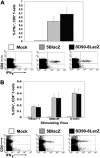Evidence for differences in immunologic and pathogenesis properties of herpes simplex virus 2 strains from the United States and South Africa
- PMID: 21498376
- PMCID: PMC3080912
- DOI: 10.1093/infdis/jir047
Evidence for differences in immunologic and pathogenesis properties of herpes simplex virus 2 strains from the United States and South Africa
Erratum in
- J Infect Dis. 2011 Aug;204(3):492
Abstract
Background: Genital infection with herpes simplex virus 2 (HSV-2) is linked to an increased risk of infection with human immunodeficiency virus (HIV) in areas such as Sub-Saharan Africa. Thus, an effective genital herpes vaccine would be an important weapon in the fight against HIV/AIDS.
Methods: To test whether a current vaccine candidate can protect against HSV-2 from Sub-Saharan Africa, we examined the ability of an HSV-2 vaccine strain, dl5-29, and other HSV-2 replication-defective mutant strains to protect against genital challenge with US or South African strains in a murine model.
Results: Immunization with dl5-29 reduces infection by both viruses but is significantly more efficacious against the US virus than against the African virus. Furthermore, another US vaccine strain was more efficacious against US than against African viruses, and the converse was observed for the parallel African vaccine strain. Nevertheless, protection against the African viruses was significantly less with all vaccines used in this study.
Conclusions: We conclude that there may be differences in protective epitopes and pathogenesis between the US and African strains that raise the need for increased doses of the existing vaccine candidate or an HSV-2 vaccine strain based on viruses from that region.
Figures






Similar articles
-
Construction and properties of a herpes simplex virus 2 dl5-29 vaccine candidate strain encoding an HSV-1 virion host shutoff protein.Vaccine. 2010 Mar 24;28(15):2754-62. doi: 10.1016/j.vaccine.2010.01.030. Epub 2010 Jan 29. Vaccine. 2010. PMID: 20117270 Free PMC article.
-
Comparison of different forms of herpes simplex replication-defective mutant viruses as vaccines in a mouse model of HSV-2 genital infection.Virology. 2001 Sep 30;288(2):256-63. doi: 10.1006/viro.2001.1094. Virology. 2001. PMID: 11601897
-
Comparison of immunogenicity and protective efficacy of genital herpes vaccine candidates herpes simplex virus 2 dl5-29 and dl5-29-41L in mice and guinea pigs.Vaccine. 2008 Jul 29;26(32):4034-40. doi: 10.1016/j.vaccine.2008.05.022. Epub 2008 Jun 2. Vaccine. 2008. PMID: 18565628 Free PMC article.
-
Herpes simplex virus-2 in the genital mucosa: insights into the mucosal host response and vaccine development.Curr Opin Infect Dis. 2012 Feb;25(1):92-9. doi: 10.1097/QCO.0b013e32834e9a56. Curr Opin Infect Dis. 2012. PMID: 22143115 Review.
-
Vaccines for Herpes Simplex: Recent Progress Driven by Viral and Adjuvant Immunology.Methods Mol Biol. 2020;2060:31-56. doi: 10.1007/978-1-4939-9814-2_2. Methods Mol Biol. 2020. PMID: 31617171 Review.
Cited by
-
Recent advances in vaccine development for herpes simplex virus types I and II.Hum Vaccin Immunother. 2013 Apr;9(4):729-35. doi: 10.4161/hv.23289. Epub 2013 Feb 26. Hum Vaccin Immunother. 2013. PMID: 23442925 Free PMC article. Review.
-
Greater Durability and Protection against Herpes Simplex Viral Disease following Immunization of Mice with Single-Cycle ΔgD-2 Compared to an Adjuvanted Glycoprotein D Protein Vaccine.Vaccines (Basel). 2023 Aug 14;11(8):1362. doi: 10.3390/vaccines11081362. Vaccines (Basel). 2023. PMID: 37631930 Free PMC article.
-
The herpevac trial for women: Sequence analysis of glycoproteins from viruses obtained from infected subjects.PLoS One. 2017 Apr 27;12(4):e0176687. doi: 10.1371/journal.pone.0176687. eCollection 2017. PLoS One. 2017. PMID: 28448558 Free PMC article.
-
Limited replication of human cytomegalovirus in a trophoblast cell line.J Gen Virol. 2021 Nov;102(11):001683. doi: 10.1099/jgv.0.001683. J Gen Virol. 2021. PMID: 34816792 Free PMC article.
-
Complete Genome Sequence of Herpes Simplex Virus 2 Strain G.Viruses. 2022 Mar 5;14(3):536. doi: 10.3390/v14030536. Viruses. 2022. PMID: 35336943 Free PMC article.
References
-
- Weiss H. Epidemiology of herpes simplex virus type 2 infection in the developing world. Herpes. 2004;11(Suppl 1):24A–35A. - PubMed
-
- UNAIDS Programme, Joint United Nations Programme on HIV/AIDS (UNAIDS). Report on the global AIDS epidemic. Geneva, Switzerland: UNAIDS; 2008.
-
- Freeman EE, Weiss HA, Glynn JR, Cross PL, Whitworth JA, Hayes RJ. Herpes simplex virus 2 infection increases HIV acquisition in men and women: ystematic review and meta-analysis of longitudinal studies. AIDS. 2006;20:73–83. - PubMed
-
- Wald A, Link K. Risk of human immunodeficiency virus infection in herpes simplex virus type 2-seropositive persons: a meta-analysis. J Infect Dis. 2002;185:45–52. - PubMed
Publication types
MeSH terms
Substances
Grants and funding
LinkOut - more resources
Full Text Sources
Other Literature Sources
Medical

